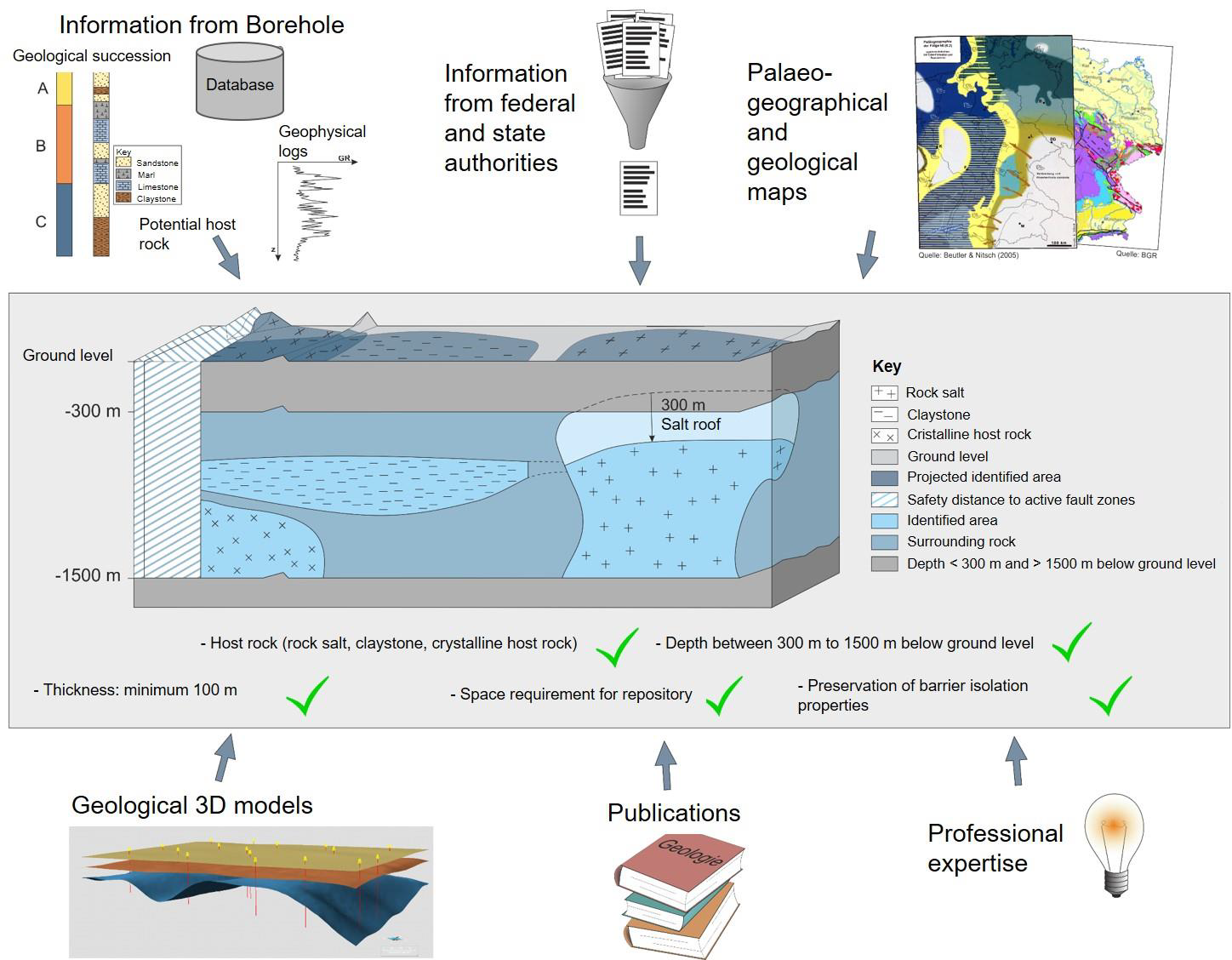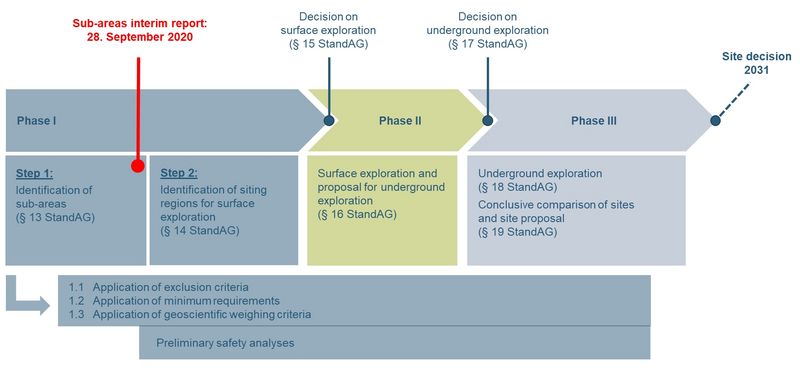¶ About the URS project
¶ Nuclear waste respository
Radioactive waste, or in other terms nuclear waste, is primarly generated during electricity production by nuclear power plants. As any other toxic waste, nuclear waste also needs to be managed safely, considering the impact of the disposal on both human health and the environment. To this date, the best solution for the final disposal is globally agreed to be deep geological disposal, and hence, Germany has also decided to dispose all radioactive waste deep underground. In the process of final disposal of nuclear waste, particular focus lies on the site selection, licensing and the operation of the selected repositories.
Radioactive waste is categorized according to their degree of radioactivity into three groups: low-, intermediate-, and high-level nuclear waste. Other important factors, such as the half-life for decay, the radiotoxicity of the waste material and the heat generation, are considered during classification and are, therefore, critical factors in the decision making for a suitable site. Germany has already found the disposal site for low- and intermediate-level nuclear waste, and at this stage, BGE (Bundesgesellschaft für Endlagerung mbH) has been commissioned to select a suitable site for high-level radioactive waste.
¶ Underground repository and the selection criteria
A repository is an underground storage for hazardous (e.g. radioactive) waste within a stable geological environment that needs to fullfill a list of minimum requirements that ensures long-term isolation and containment without the need of future maintenance. The repository includes the stored radioctive waste, the containers enclosing said waste, other possible engineered barriers around the containers, the tunnel around the containers/additional barriers, and the surrounding geological rock formation.

The first step in the selection process involved the exclusion of areas that are unsuitable as repository sites in Germany for high-level radioactive waste according to the legal exclusion criteria given in StandAG. The remaining areas were first classified into rock formation categories (claystone, rock salt and crystalline host rocks), then they were assessed acccording to the minimum requirements referring to hydraulic conductivity of the rock, the thickness of the effective containment zone, the minimum depth of the effective containment zone (i.e. its distance to the earth’s surface), the assumed minimum area of the repository and the preservation of the barrier effect.
In the last step, these identified areas are evaluated according to the geoscientific weighing criteria defined in Section 24 StandAG in regard to their favourable overall geological situation and hence their suitability as a repository site for high-level radioactive waste. These eleven criteria refer to:
- transport of radioactive substances by groundwater movements in the effective containment zone;
- configuration of the rock bodies;
- spatial characteristics;
- long-term stability of the favourable conditions;
- favourable geomechanical properties;
- tendency to form fluid pathways;
- gas formation;
- temperature compatibility;
- retention capacity in the effective containment zone;
- hydrochemical conditions; and
- protection of the effective containment zone by the overburden.
¶ Challenges in the safety assessment process
The difficulty in the process of site evaluation in regard of its long-term safety performance comes from the various types of uncertainties arising during the assessment. The main source of these uncertainties includes:
- safety must be ensured over very long period of times (up to thousands or millions of years);
- the large-scale spatial areas that must be considered during the assessement;
- the repository system itself is a very complex geological system that is nearly impossible to exactly describe by mathematical models, and by using conceptual and/or computer models attempting to describe the long-term behavior of repository systems brings forth uncertainties;
- the inaccuracy of the repository specific assessment data originating from the imprecision in values or the application of implicit measurement methods; and
- human subjectiveness during the expert's judgement with respect to the validity of the applied models.
In order to deal with these uncertainties, a combination of quantitative and qualitative criteria and methods is required that shall be used in a systematic and comprehensive manner. Scenario development is a commonly used approach to predict the specific site performance consisting of a list of geological, man related and waste-repository interaction caused phenomena that may lead to the potential failure of the repository. Frequent scenario analysis methods are e.g. the fault-event-tree method (repository represented by a schematic diagram with elements defining failure events that is assessed by quantitative risk analysis), simulation methods (repository described by a set of physico-chemical processes with superimposed random discrete events followed by uncertainty quantification and sensitivity analysis, e.g. Monte Carlo method or Bayesian method), and experts opinion (a qualitative judgemental method involving high level of relevant knowledge on a particular repository situation).
¶ Research goals

The site selection procedure launched in September 2017, and Phase I was completed in September 2020 with 90 areas identified with favourable geological conditions in accordance with the Site Selection Act (StandAG). As a next step, preliminary safety investigations (PSI) are to be carried out in order to propose which siting regions should undergo surface exploration. In the course of PSI, assumptions are made regarding the suitability as a site with the best possible safety considering interpretations of geological and geophysical data, analogies and geoscientific models. The uncertainties that are associated with each of these elements are regulated according to the Final Safety Investigation Ordinance (EndlSiUntV) and are handled as follows:
- Uncertainties shall be systematically identified and characterised.
- The handling of uncertainties and their effects on the information value of the PSI results and on the reliability of safety-related statements shall be documented.
- It shall be shown whether and to what extent existing uncertainties can be reduced by further exploration, research and development measures.
To fullfill these tasks BGE called for a research cluster to investigate the various topics regarding uncertainties in order to improve the robustness and thus the safety of a repository, including the expansion of the state of knowledge of uncertainties and the development of methods dealing with these uncertainties. The research cluster consist of six research associations that deal with different questions regarding the handling of uncertainties. A full list of all research participants can be found here, and the respective research associations and their focal points on the sites under the Research section.